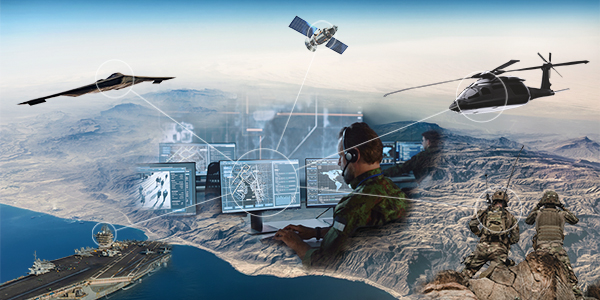Over the years, the Department of Defense (DoD) has faced new and threatening adversaries that have challenged command-and-control networks. These adversaries have undermined the military’s ability to maneuver within the battlespace. As such, commanders need to make decisions within seconds, minutes, and hours instead of days. The DoD has partnered with the aerospace and defense industry to help solve one of the most complex challenges for the warfighter – enabling Joint All Domain Operations (JADO) and implementing Joint All-Domain Command and Control (JADC2).
Connecting Intelligence, Surveillance and Reconnaissance (ISR), tactical, and joint service networks will create the data fabric on which commanders can build a Common Operating Picture (COP) to enable faster decision making. This is key to realizing the vision for JADC2. Networks must operate securely with one another to ensure a seamless and accurate flow of information across all warfighting and security domains.
But a single network cannot be all things to all users in every domain. Integrating multiple networks from across the services and coalition partners into a Unified Network gives the best overview of the battlefield for situational analysis and rapid decision making. And bringing all these networks together is not a singular activity. It will continually evolve as new capabilities, networks, and platforms become available – while continuing to work with legacy solutions and fleets. This requires an open architecture approach to not only meet the speed of integration, but also maintain ongoing authority to operate.
Securely Integrating Networks is Critical
When different networks are connected, the data can be trapped in different security classifications. In these situations, Cross-Domain Solutions (CDS) provide the ability to unlock trapped data. CDS can send data from the larger tactical datalink network and select the appropriate data for differing audiences – based on security levels – to develop an operating landscape amongst joint service and coalition users. Having a comprehensive understanding of the battlespace enables advanced situational awareness for strategic, timely decisions within multi-domain operations.
Because current networks have limitations in scaling to the number of users that need to be supported within a potentially large operating network range, networks need to scale to hundreds and thousands of users and operate at long distances within a contested environment. Addressing all these issues requires advanced tactical datalink solutions that can connect users and data at scale and range.
Demonstrating capabilities now
Collins Aerospace is tackling these challenges by focusing in three specific areas:
- Using an open architecture approach to network integration for existing and emerging networks.
- Unlocking the data flow to all joint service and coalition users with CDS to securely provide approved data to appropriate users.
- Using advanced tactical networks that address both the scale and range requirements for current and future operations.
Throughout the past year, Collins has conducted multiple demonstrations proving it is possible to successfully integrate these networks. These presentations showcased advanced mesh networks that scaled to the number of supported users at an increased range. Collins also brought together advanced and existing networks using gateway and cross-domain solutions to move data seamlessly among users at different security levels.
These demonstrations have proven that technology is available now to move data around and leverage enhanced connectivity to solve operational problems. In December 2021, Collins successfully integrated sensors, networks, Command & Control, and effectors across the joint services and coalition partners that facilitated shorter kill chains.
These exhibitions generate leave-behind capabilities that bring operational benefit to today’s warfighter. By continuing to develop and add functionality, the aerospace and defense industry will incrementally help the DoD in its efforts to build up JADC2 networks.






















